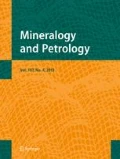Summary
Monazite occurs as an accessory mineral in a variety of rock types in the granulite belt of the Eastern Ghats, India. Five types of monazite paragenesis are distinguished based on the mode of occurrence. They include: 1) tiny inclusions in cordierite and garnet occurring in khondalites and charnockites, 2) distinct grains in charnockite, 3) associated with other phosphates (apatite and xenotime) in magnetite-spinel-sillimanite-sapphirine granulites, 4) well-developed grains in charnockites affected by shearing and 5) clustered grains in metasomatised pyroxenites. Microprobe analyses of these monazites show that they have some distinct chemical characteristics, mainly in terms of ELREE (La + Ce + Pr + Nd + Sm)/Actinides (U + Th) and ELREE/Y ratios. The chemistry of monazites supports the interpretation that actinides substitute for LREE, and implies other concomitant substitutions such as Ca for REE and Si for P. Among the five types of monazites, type 2 monazite is concentrated in greater abundance in some of the heavy mineral placer deposits along the east coast of India.
Zusammenfassung
Monazit tritt als akzessorisches Mineral in verschiedenen Gesteinstypen des Granulit-Gürtels der Ost-Ghats, Indien, auf. Aufgrund seines Vorkommens, können fünf verschiedene Monazit-Paragenesen unterschieden werden: 1) winzig kleine Einschlusse in Cordierit und Granat aus Khondaliten und Charnockiten, 2) Einzelkörner im Charnockit, 3) zusammen mit anderen Phosphaten (Apatit und Xenotim) in Magnetit-Spinel-Sillimanit-Saphir-Granuliten, 4) gut ausgebildete, jedoch zerscherte Körner im Charnockit und 5) verteilte Körner in metasomatisierten Pyroxeniten. Mikrosonden-Analysen zeigen, daB die Monazite durch ganz bestimmte LREE (La + Ce + Pr + Nd + Sm)/Aktividen (U + Th) und LREE/Y Verhältnisse charakterisiert sind. Der Chemismus der Monazite bestatigt den Ersatz der LREE durch die Aktiniden, und deutet gleichzeitige Substitution der REE durch Ca und des P durch Si an. Von den fünf verschiedenen Monazitarten, ist der Typ 2 in größerer Anzahl in einigen der Schweremineralseifen entlang der Ostküste Indiens konzetriert.
Similar content being viewed by others
References
Aswathanarayana U (1964) Isotopic ages from the Eastern Ghats and Cuddapahs of India. Geophys Res 69: 3479–3486
Fleischer M, Altschuler ZS (1969) The relationship of the rare earth composition of minerals to geological environment. Geochim Cosmochim Acta 33: 725–732
Grew ES, Manton WI (1986) A new correlation of sapphirine granulites in the Indo-Antarctic metamorphic terrain: Late Proterozoic dates from the Eastern Ghats Province of India. Precamb Res 33: 123–137
Grasty RL, Leelanandam C (1965) Isotopic ages of basic charnockite and khondalite from Kondapalli, Andhra Pradesh. Miner Mag 35:529–535
Kamineni DC, Bonardi M, Rao AT (1982) Halogen-bearing minerals from Airport Hill, Visakhapatnam, India. Am Mineral 67:1001–1004
Kamineni DC, Rao AT (1988a) Sapphirine-bearing quartzite from the Eastern Ghats granulite terrain, Vizianagaram, India. J Geol 96: 209–220
—— (1988b) Sapphirine granulites from the Kakanuru area, Eastern Ghats, India. Am Mineral 73: 692–700
Lal RK, Ackermand D, Upadhyay H (1987) P-T-X relationships deduced from corona textures in sapphirine-spinel-quartz assemblages from Paderu, Southern India. J Petrol 28: 1139–1168
Mahadevgn C, Sriramadas A (1948) Monazite in the beach sands of Vizagapatnam District. Proc Indian Acad Sci 27A: 275–279
Mannucci G, Diella V, Gramaccioli CM, Pilati T (1986) A comparative study of some pegmatitic and fissure monazite from the Alps. Can Mineral 24: 469–474
Masuda A, Nakumura N, Tanaka T (1973) Fine structure and mutually normalized rare-earth patterns of chondrites. Geochim Cosmochim Acta 37: 239–248.
Murata KJ, Dutra CV, Da Costa MT, Branco JJR (1958) Composition of monazites from pegmatites in eastern Minas Gerais, Brazil. Geochim Cosmochim Acta 16:1–14
—— (1953) Systematic variation of rare earths in monazite. Geochim Cosmochim Acta 4:292–300
— (1957) Systematic variation of rare-earth elements in cerium-earth minerals. Geochim Cosmochim Acta 11: 141–161
Murthy MS (1958) Occurrence of monazite in the Charnockites of Visakhapatnam. Current Sci 27: 347–348
Natarajan V, Nanda JK (1981) Large scale basin and dome structures in high grade metamorphics near Visakhapatnam, South India. Geol Soc India 22: 584–592
Perraju P, Kovach A, Svingor E (1979) Rubidium-strontium ages of some rocks from parts of the Eastern Ghats in Orissa and Andhra Pradesh, India. J Geol Soc India 20:290–296
Ramamohana Rao T, Shanmukha Rao Ch, Sanyasi Rao K (1982) Textural analysis and mineralogy of the black sand deposits of Visakhapatnam-Bhimunipatnam coast, Andhra Pradesh, India. J Geol Soc India 23: 284–289
Rao AT (1976) Study of apatite-magnetite veins near Kasipatnam, Visakhapatnam District, Andhra Pradesh, India. Tschermaks Min Petr Mitt 23: 87–103
—— (1980) Cheralite from beach placers of Visakhapatnam-Bhimunipatnam coast. Indian J Marine Sci 9: 214–216
Sarkar A, Bhanumathi L, Balasubrahmanyan MN (1981) Petrology, geochemistry and geochronology of the Chilka Lake igneous complex, Orissa State, India. Lithos 14:93–111
Semënov EI (1963) Mineralogy of the rare earths. USSR Academy of Sciences (in Russian)
—— (1978) Rare earth minerals of carbonatites of Tamilnadu. Geol Soc India 19: 550–557
Srinivasa Sastry C (1954) Heavy minerals of charnockites and leptynites. Current Sci 23: 151–152
Author information
Authors and Affiliations
Rights and permissions
About this article
Cite this article
Kamineni, D.C., Rao, A.T. & Bonardi, M. The geochemistry of monazite types from the Eastern Ghats granulite terrain, India. Mineralogy and Petrology 45, 119–130 (1991). https://doi.org/10.1007/BF01164599
Received:
Accepted:
Issue Date:
DOI: https://doi.org/10.1007/BF01164599




